A Guide to Low Heel Ballroom Dance Shoes
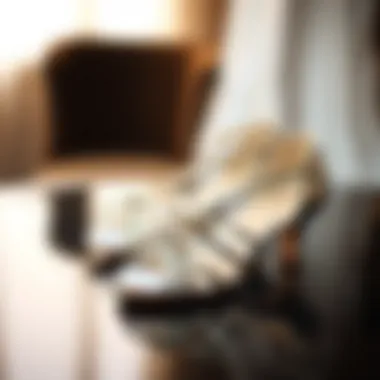
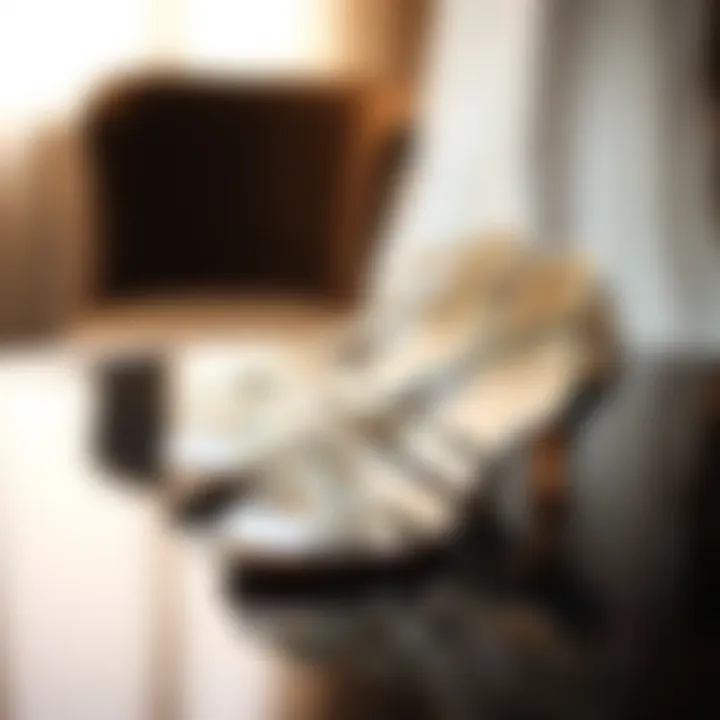
Intro
Navigating the realm of ballroom dance can be both exhilarating and daunting, especially when it comes down to the choice of footwear. Low heel ballroom dance shoes have emerged as a favored option among dancers of various styles, mixing practicality with elegance. The right pair not only boosts performance but also enhances comfort. In this guide, we’ll dissect the intricate design features, comfort aspects, and specific styles that make low heel shoes an essential part of the dancer's arsenal.
When you dance, your feet are your foundation. Having the right shoes can make the difference between a graceful performance and one that feels restricted. As we embark on this exploration, understanding the trends in footwear can greatly improve not only your skills on the dance floor but also align your style with the latest fashion buzz.
Clothing Trends
Seasonal Must-Haves
The world of fashion is ever-changing, and ballroom dance shoes are no exception. Each season brings forth its unique trends. For instance, during the spring and summer months, lighter fabrics and pastel colors dominate the scene. Shoes crafted from breathable materials enhance comfort for longer dance sessions. The likes of satin or lightweight leathers in soft greens, yellows, and blues can add a flirty touch to your ensemble.
In contrast, the fall and winter seasons often call for deeper hues, such as burgundy and navy. These colors resonate well with classic ballroom styles, allowing for a subtler yet refined look.
Iconic Styles Through Decades
Ballroom dance shoes have unveiled various styles through the decades, each reflecting the changing tastes and cultures. The 1920s brought forth heels that were slightly lower than what was fashionable in previous times. Today’s low heel designs echo that sentiment while favoring functionality and comfort.
As you rummage through your closet or search the market, look for designs that pay homage to the classics, like Mary Janes or peep-toe styles, which remain ever-popular for their versatility.
"Fashion is like dancing; it’s about finding your rhythm and style, and the shoes are your partners in this dance."
Fashion Tips
Styling Essentials for Every Occasion
Finding the perfect low heel ballroom shoe boils down to understanding the event you’re dressing for. A classical performance demands elegance, so opt for shoes that come in soft, luxurious materials—think suede or satin. However, for practice or social events, comfort might take precedence, making appropriately cushioned shoes a better match.
- For formal events, consider darker colors paired with understated outfits.
- Casual gatherings allow for more playful and bright designs, embracing fun patterns or embellishments.
Accessorizing to Elevate Your Look
Accessories can make or break an outfit, even when it comes to dance apparel. When wearing low heel ballroom shoes, consider accentuating your outfit with a matching clutch or earrings that tie everything together.
- Sashes or belts that complement the shoe color can introduce a polished touch.
- Scarves can be utilized not just for warmth but also as a fashion accessory around the waist or in your hair.
Caring for your footwear is also crucial. Regularly clean your shoes to maintain their aesthetic appeal and ensure they last through many dance sessions. Always remember, looking good augments the confidence with which you express your art.
Prelims to Ballroom Dance Shoes
When it comes to the world of dance, the right footwear can make all the difference. This holds true for ballroom dancing, where the grace of movement is often dictated by the shoes worn. Understanding ballroom dance shoes is essential, as they are not just any ordinary pieces of footwear; they play a critical role in performance, posture, and even safety on the dance floor.
Selecting the appropriate shoes can lead to an enhanced dancing experience, providing dancers with not just support but also flair. The subtleties of shoe design can impact a dancer's ability to execute various moves with confidence. Whether one is an aspiring professional or a social dancer, knowing the ins and outs of ballroom dance shoes, especially low heel options, is invaluable.
Understanding the Importance of Footwear in Dance
The connection between footwear and dance performance is deeper than many might realize. Shoes designed specifically for dancing—like those for ballroom—offer features that regular shoes do not. They are typically crafted to facilitate movement while providing the necessary grip on dance floors that can vary from slick to textured. The benefits include:
- Support: A well-designed shoe contours to the foot, supporting arches and minimizing fatigue.
- Motion: The right shoes enable quick transitions and turns, crucial for many ballroom styles.
- Balance: The balance provided by the shoes plays a major role in performance, allowing for elegant styling without compromising stability.
Thus, choosing the right footwear is not merely a matter of aesthetics; it profoundly affects a dancer's ability to perform their best.
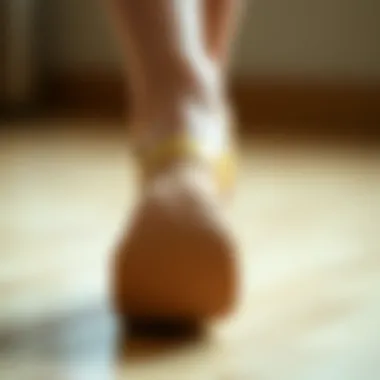
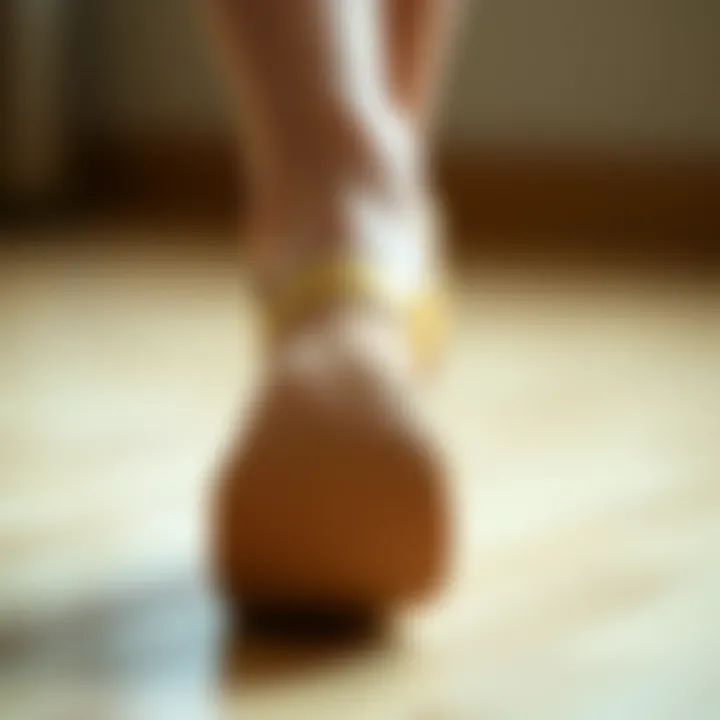
A Brief Overview of Dance Shoe Types
Understanding the landscape of dance shoes includes recognizing the various types available. For ballroom dancing, shoes are generally categorized into:
- Standard Shoes: Typically characterized by a wider toe box and low heel, offering stability for dances like waltz or foxtrot.
- Latin Shoes: These often have a higher heel and are designed for faster, more dramatic movements typical in dances like salsa or rumba.
- Practice Shoes: More casual in design, these are often used during lessons and provide comfort over long periods.
- Low Heel Shoes: A preferred choice for many, these shoes provide a balanced combination of style and safety, allowing dancers to perform without compromising on comfort.
By dissecting these options, dancers can make informed decisions based on their specific needs, preferences, and dance styles.
Low Heel Options: Characteristics and Benefits
When it comes to ballroom dancing, the shoes you wear are as vital as the moves you perform. Low heel options are gaining traction among dancers of all levels, and for good reason. Understanding the characteristics and benefits of these shoes not only enhances performance but also helps in making informed purchasing decisions. Low heel shoes provide a fine balance between comfort, stability, and style while catering to a wide range of dance forms.
Defining Low Heel in Dance Context
In the dance world, a low heel typically measures around one to two inches in height. These shoes are designed to maintain the dancer's center of gravity, ensuring stability when executing intricate steps and spins. The characteristics of low heels include a wider base, which prevents wobbling and promotes better balance. With lower heels, dancers can navigate the floor more effortlessly, reducing the risk of losing their footing. This functionality is particularly advantageous for those who might be new to dance or prefer a more grounded feel on the floor.
Advantages of Low Heel Shoes
Low heel ballroom dance shoes come with a myriad of advantages, making them a preferred choice for many performers. Some notable benefits include:
- Enhanced Comfort: The lower heel reduces strain on the ankles and feet, allowing for longer periods of wear without discomfort.
- Better Stability: Dancers can maintain a solid base, ensuring better control during performances, especially in styles like Latin and salsa.
- Versatility: From graceful waltzes to lively quicksteps, low heel shoes can adapt to various dance styles, making them an ideal option for dancers who enjoy experimenting.
- Reduced Injury Risk: The combination of comfort and stability means fewer injuries, as the foot is less likely to be forced into unnatural positions.
Staying on one's feet comfortably is crucial in dance; thus, these benefits establish low heel shoes as an excellent choice.
Comparison with High Heel Dance Shoes
It's essential to explore how low heels stack up against their high-heeled counterparts.
- Posture and Mobility: High heel shoes can accentuate posture but often at the cost of mobility. Dancers may find high heels restrictive and unstable, particularly when mastering complex routines. Conversely, low heels allow for more flexibility and natural movement.
- Fatigue Factor: Dancers may fatigue faster in high heels due to the elevated angle and pressure on the forefoot. Low heels distribute weight more evenly, alleviating pressure points and ensuring endurance on the dance floor.
- Aesthetic Appeal: While high heels often add elegance, low heels bring an understated sophistication. The simplicity can compliment a variety of outfits without overshadowing the overall look.
"Choosing the right shoe isn’t just about aesthetics; it plays a key role in performance and comfort. Low heels allow you to focus on your art rather than your feet."
In summary, understanding the characteristics and benefits of low heel options is paramount for anyone invested in ballroom dance. With their unique features and benefits, they successfully marry the needs of performance with the comfort and stability that every dancer craves.
Selecting the Right Fit and Style
Choosing the right fit and style for low heel ballroom dance shoes is pivotal for both performance and comfort on the dance floor. Unlike regular footwear, these shoes are specifically tailored to meet the unique demands of dance, where movement, poise, and stability are key. A well-chosen shoe not only enhances your dancing experience but also boosts your confidence, allowing for fluid movements and graceful execution of steps. When venturing into the realm of low heel shoes, several specific elements come into play that can significantly affect how effectively a dancer performs.
Identifying the Correct Size
Finding the perfect size is the cornerstone of selecting appropriate dance shoes. While one might usually wear a certain number in day-to-day footwear, dance shoes often fit differently due to their construction and purpose. Ideally, the fit should feel snug but comfortable—your toes should lightly touch the front of the shoe without being cramped. Dancers need to keep in mind that these shoes are designed to allow for some stretching as they break in.
It’s often wise to try on shoes later in the day when your feet are at their largest to get the most accurate feel.
It can also be beneficial to know about the width of the shoe. Some brands might offer various widths, accommodating a range of foot shapes. Additionally, standing and walking in them can provide insight into how well they fit. It's a good idea to do a few dance steps in the store if possible, ensuring that comfort is consistent with movement.
The Role of Material in Comfort and Performance
The materials used in low heel dance shoes play a crucial role in determining how comfortable and effective they will be during performances. Common materials include leather, satin, and synthetic fabrics. Each material brings its own set of advantages.
- Leather: Often regarded as the gold standard due to its durability and breathability, leather conforms to your foot over time, enhancing comfort.
- Satin: This material gleams under the spotlight, perfect for competition and shows, but you must consider its breathability. It might not be as forgiving during long practices.
- Synthetic Fabrics: While often lighter and more cost-effective, they may lack the longevity and comfort of leather. However, new technology continues to improve these materials.
When purchasing, feel the shoe and assess how it flexes with your foot. Search for additional features like padded insoles and arch support, as these contribute substantially to comfort and performance.
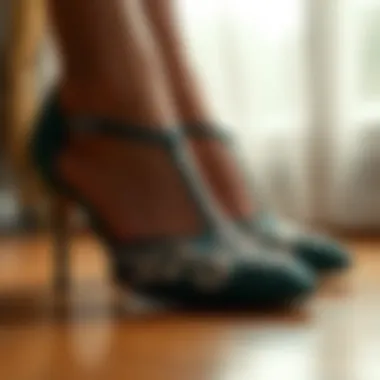
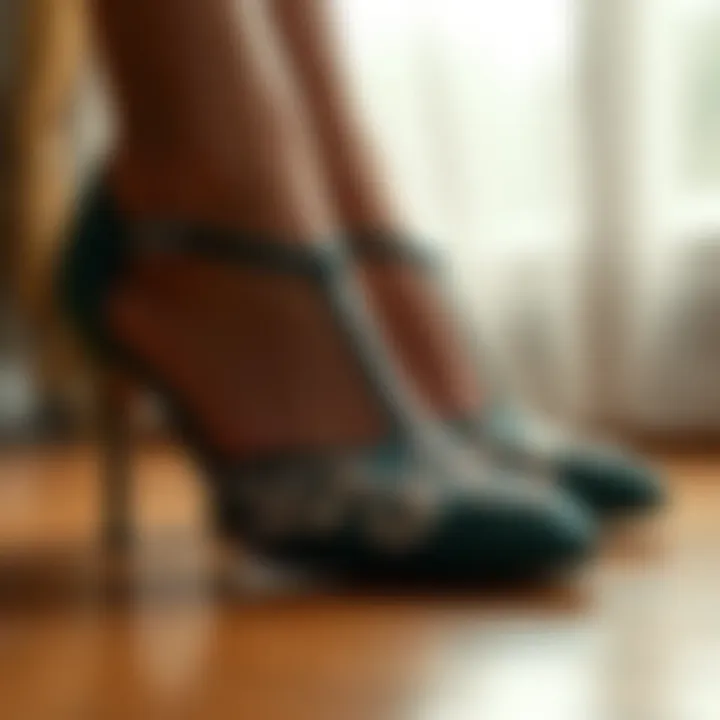
Choosing the Appropriate Design for Your Dance Style
Different dance styles often benefit from specific shoe designs. When it comes to ballroom dancing, factors such as the type of dance being performed—be it waltz, tango, or cha-cha—can influence shoe selection.
- Waltz: Shoes that facilitate smooth gliding across the floor are essential. Look for a shoe design that offers a wider sole for better stability.
- Tango: Here, a more structured shoe may be necessary to aid sharp movements and swift changes in direction.
- Cha-Cha: A lightweight shoe will allow for greater footwork and agility.
Consider also the aesthetic appeal; you may want to choose designs that resonate with your dance style while also allowing expression of personal flair. Look into various color options, patterns, and embellishments that align with the vibrant nature of ballroom dance.
Selecting the right fit and style is an intricate process, requiring careful thought about size, material, and design. Ultimately, when a dancer feels good in their shoes, it translates to an enhanced performance, creating a harmonious blend of skill and style.
Popular Brands for Low Heel Ballroom Dance Shoes
Selecting the right brand for low heel ballroom dance shoes is more than just a matter of choice; it’s an investment in comfort, performance, and style. As dancers glide across the floor, their shoes play a pivotal role in enhancing their skills while expressing individual flair. This section discusses established brands that have stood the test of time and emerging labels that offer fresh perspectives in design and technology.
A Look at Established Brands
When it comes to reliability, established brands like Bloch and Capezio have a storied history in the realm of dance footwear. These companies have been around for decades, garnering a reputation for quality and innovation.
Bloch, for instance, is known for its ergonomic designs that prioritize both comfort and functionality. Their low heel shoes typically feature soft leather uppers, providing a snug fit that allows for extensive movement without pinching the toes or causing blisters.
Similarly, Capezio, another veteran brand, has earned respect for its stylish yet durable footwear. Dancers often appreciate their low heel options, which incorporate cushioned insoles that offer superior shock absorption.
Benefits of Choosing Established Brands:
- Trustworthy Quality: They often use durable materials that withstand rigorous training.
- Consistent Fit: Sizes are often more standardized across their product lines.
- Proven Track Record: Their shoes are tried and tested by professionals and amateurs alike.
Emerging Brands to Consider
While big names have made their mark, the dance industry is abuzz with emerging brands that bring new ideas to the table. Take Supadance for instance; this brand has gained traction in the ballroom community thanks to its emphasis on combining fashion with function. Their low heel shoes often feature modern designs while still adhering to the classic ballroom aesthetic, appealing to a younger generation of dancers.
Another noteworthy newcomer is Dancewear Corner, which focuses on customizing footwear based on individual needs. Their low heel options allow for bespoke fittings, catering to those dancers who struggle with standard shoe sizes.
Key Considerations When Exploring Emerging Brands:
- Material Innovation: Such brands often experiment with new fabrics that enhance breathability and flexibility.
- Unique Designs: They can offer less conventional styles that align with current fashion trends.
- More Competitive Pricing: Often, newer brands provide attractive price points compared to established names, making it easier for dancers on a budget to find quality options.
Given the vast range of brands available, it's crucial for dancers to weigh their choices carefully. Whether leaning towards established brands for their track history or exploring emerging alternatives for stylish innovations, understanding the pros and cons can guide one toward the perfect fit for their dance journey.
Caring for Your Ballroom Dance Shoes
Proper care for your ballroom dance shoes might not be the first thing on your mind when you lace up for a night of gliding across the dance floor. However, the reality is that well-maintained shoes can significantly enhance your performance, ensuring that every step feels as light as a feather. Understanding how to care for your footwear is not just about cleaning or storage; it’s about preserving those delicate yet essential pieces of your dance journey.
Maintenance Tips for Longevity
To maximize the lifespan of your low heel ballroom dance shoes, adopting a robust maintenance routine is essential. Here are some strategies to consider:
- Regular Inspection: After each use, look over your shoes for any signs of wear and tear. This can include checking the soles for scuffs and the upper part for any fraying or damage.
- Use Shoe Trees: Inserting shoe trees after each session helps preserve the shape of the shoes and absorbs moisture, which can extend their life significantly.
- Avoid Excess Moisture: Ballroom shoes, especially those made with suede, can be sensitive to water. If they get wet, dry them at room temperature and avoid direct heat, which can warp the materials.
- Rotate Your Shoes: If you dance frequently, consider alternating between a few pairs. This allows individual shoes to air out and reduces the risk of excessive wear on one pair.
Cleaning Techniques for Different Materials
Different materials require distinct cleaning techniques to keep them in tip-top shape. Here's a breakdown:
- Suede: Start by using a suede brush to remove dirt and debris gently. For stains, a suede eraser can help lift marks without damaging the material. Avoid water, as it ruins the texture.
- Leather: Soft cloths can work wonders here. Wipe down leather shoes after each use to remove sweat and oils. Consider using a tiny amount of leather conditioner every few months to maintain flexibility.
- Patent Leather: This shiny finish can be cleaned with a damp cloth followed by a dry one to restore its glossy appearance. For stubborn marks, a small dab of nail polish remover on a cloth can help, but test it first to prevent damage.
By keeping your ballroom dance shoes clean and taking a moment to conduct regular maintenance, you'll not only enhance their durability but also ensure they remain a trustworthy partner on the dance floor.
"Taking good care of your footwear can mean the difference between a good dance and a great dance. Treat them like allies, and they’ll serve you well!"

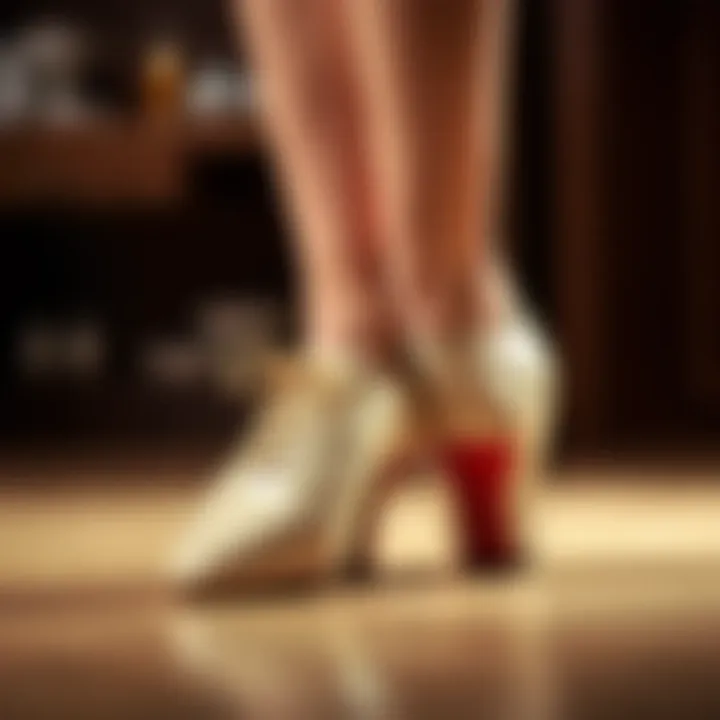
Balancing Style and Functionality
Finding the right balance between style and functionality is crucial when selecting low heel ballroom dance shoes. Many dancers often find themselves at a crossroads, wanting shoes that not only look good but also perform well on the dance floor. This section explores how these two aspects can coexist, ensuring that dancers can express their personal style without compromising on comfort and practicality.
Current Trends in Ballroom Dance Fashion
Ballroom dance fashion is constantly evolving, reflecting broader trends in the fashion industry while maintaining its unique character. Currently, there is a notable shift towards more vibrant colors and daring designs, which appeals to both novice and seasoned dancers. Dancers are increasingly opting for bold patterns and textures, which can transform the ordinary into the extraordinary, allowing them to stand out during competitions or performances.
In this age of social media, trends are influenced by what celebrities and influencers wear. For instance, the rise of modern fabrics with breathable properties has changed the game, making it easier for dancers to look fabulous while still being comfortable. Shoes featuring intricate beadwork, unique straps, and a variety of heel heights are gaining traction. The key elements in these trends include:
- Sustainable materials: With increased awareness of environmental issues, brands are beginning to use eco-friendly materials and ethical manufacturing processes. This not only appeals to a socially conscious audience but also showcases style that aligns with modern values.
- Customization: Many brands now offer customizable options, allowing dancers to choose colors, materials, and embellishments that reflect their personal style. This not only enhances aesthetic appeal but also gives dancers a sense of ownership over their footwear, further bridging the gap between style and functionality.
- Comfort-first design: As understanding of the importance of comfort in performance grows, many brands now integrate supportive features such as cushioned insoles and arch support within stylish silhouettes. This exemplifies how functionality can enhance style without losing appeal.
Incorporating Personal Style into Dance Shoes
When it comes to dance, personal style is an extension of oneself, and incorporating that into dance shoes is essential. The shoes you choose can significantly affect how you feel and perform on the dance floor. Here are some ways to incorporate personal style:
- Color choices: Selecting colors that resonate with your personality can make a significant impact. If you love bold looks, vibrant hues can complement your dancing, whereas muted tones can convey sophistication and subtlety.
- Design features: Opt for shoes with distinctive design elements like unique buckle styles or artistic stitching that mirror your personal aesthetic. Whether it's whimsical or classy, your shoe's design should express who you are.
- Accessorizing: Don't shy away from adding personal flair with accessories. Brooches, ribbons or even your own created embellishments can add a customized touch to your shoes without sacrificing functionality.
"Dancing is the poetry of the foot, and your shoes should be its canvas."
Performance Aspects of Low Heel Shoes
Selecting the right footwear for any dance style is pivotal, and low heel ballroom shoes are no exception. Their performance attributes directly influence a dancer's technique and adaptability, making them crucial for both amateurs and seasoned professionals. Understanding how these shoes perform can help dancers make educated choices that align with their needs and goals.
Impact on Dance Technique
Low heel shoes are designed to provide a unique blend of support and flexibility, which plays an essential role in enhancing a dancer's technique. Unlike their high-heeled counterparts, these shoes allow for a more grounded connection with the floor. This connection is vital, as it helps in executing movements with precision and control. When dancers wear low heel shoes, they often find it easier to maintain balance while turning, spinning, or executing complex footwork.
- Stability: Low heel shoes typically feature a broader base, distributing weight evenly. This makes it easier to pivot without losing balance, allowing dancers to perform with confidence.
- Foot Alignment: The reduced height encourages proper foot alignment, which is a key aspect of many dance styles. Dancers are less prone to strain and injury, enabling them to move as fluidly as possible.
It’s important to note that the fit of the shoe significantly affects these aspects. An ill-fitting shoe can hinder performance and lead to missteps during crucial moments of a dance sequence. Thus, finding the right pair becomes just as important as the design itself.
Adaptability to Different Dance Floors
The versatility of low heel ballroom shoes is another hallmark feature that cannot be overlooked. Different ballroom dance events often take place on varying surfaces, from polished wood to carpeted floors.
- Surface Compatibility: Low heel shoes are often crafted with suede soles, which strike a balance between traction and slide, allowing dancers to adapt seamlessly to different floor types. This flexibility means a dancer can perform without having to worry about slipping or losing grip on the dance floor.
- Variety of Dance Styles: Whether it's waltz, tango, or cha-cha, low heel shoes can adapt to the unique demands of each style. The design caters to those quick transitions and sharp movements that define various dances, ensuring dancers achieve their best performance.
"Choosing the right dance shoe isn’t merely a matter of aesthetics; it fundamentally impacts your style and performance."
By understanding these performance characteristics, dancers make more informed choices that align not only with their personal style but also with the requirements of the dances they engage in.
End: Making an Informed Choice
When it comes to low heel ballroom dance shoes, making an informed choice can significantly influence both your dancing performance and your overall enjoyment on the dance floor. Throughout this guide, we’ve explored the essential aspects of low heel shoes—from their unique benefits and design features to care and maintenance tips. The shoes you select not only affect your foot health but also play a crucial role in executing your dance techniques with precision.
Recapping Key Considerations
As we wrap up, let's revisit some key factors that you should keep in mind when choosing your low heel ballroom dance shoes:
- Fit is Paramount: Shoes should fit snugly without pinching. It’s advisable to try on different sizes and styles, as sizing can vary between brands.
- Material Matters: Look for breathable materials that mold to your foot's shape. Materials like soft leather or satin can provide extra comfort.
- Design Versatility: Opt for designs that can serve multiple dance styles. A shoe that performs well in both salsa and ballroom can broaden your dancing experience.
- Maintenance: Regular care ensures your shoes last longer. Understand how to clean and store them properly.
- Performance Needs: Consider how the shoe helps you move on various dance floors. Different surfaces may require different attributes in your shoe.
Final Thoughts on Low Heel Ballroom Dance Shoes
Investing in quality footwear not only enhances your performance but also protects your feet, making informed choices an absolute necessity. As you step out onto the dance floor, remember that the right shoe can be the difference between a good dance and a great one. So choose wisely, and let your dancing shine.
"Good footwear is the foundation of great dancing."
For more on dance shoe selection and care, visit resources like The Dance Shoe Store or check insightful discussion threads on reddit.com/r/Dance. Let your dance journey be one of comfort, style, and unmatched performance.















